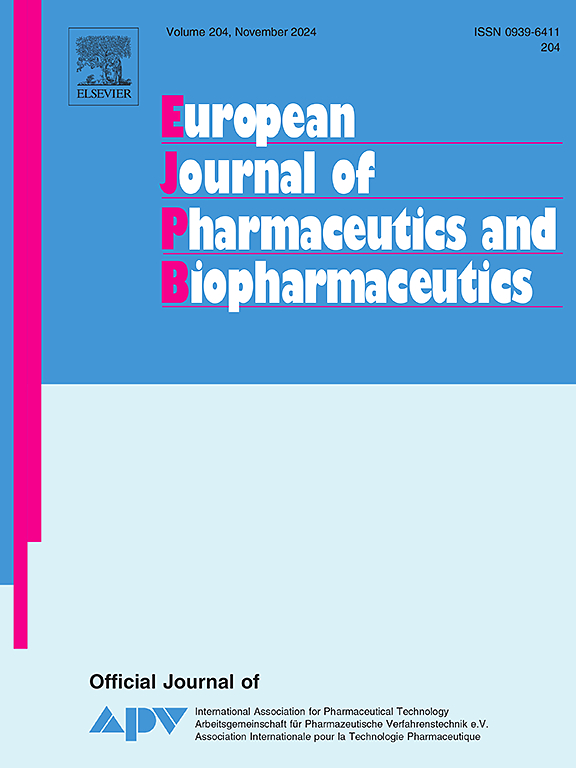Controlled release of deferiprone using iron-responsive nanoparticles integrated with dissolving microneedle for novel alternative treatments of β-thalassemia major
IF 4.4
2区 医学
Q1 PHARMACOLOGY & PHARMACY
European Journal of Pharmaceutics and Biopharmaceutics
Pub Date : 2025-03-24
DOI:10.1016/j.ejpb.2025.114702
引用次数: 0
Abstract
Iron chelating agents (ICs) such as conventional deferiprone are often ineffective when exposed to normal conditions due to their uncontrolled release when treating iron overload in ß-thalassemia major (ß-TM) due to the effects of blood transfusion. Iron deficiency and gastrointestinal side effects are crucial problems that can occur. Therefore, DFP was prepared as nanoparticles (NPs) coated with an iron-responsive (IR) polymer with an average particle size of 354.70 ± 10 nm to control its release. To facilitate optimal delivery, NP-IR-DFP was integrated into a dissolving microneedle (DMN) fabricated with biodegradable and biocompatible poly(vinylpyrrolidone) and poly(vinyl alcohol) polymers. The results showed that the NP-IR-DMN provided excellent insertion and mechanical strength and dissolved quickly after application. In vitro and ex-vivo studies revealed the more controllable release of NP-IR-DFP after integration with the DMN (NP-IR-DMN) for up to 24 h. Most importantly, the developed formula was hemocompatible and did not irritate the skin or cause tissue damage. Furthermore, the in vivo pharmacokinetics were further investigated for 24 h, which revealed short concentration (Cmax of 0.07 ± 0.03 μg/mL) and t1/2 (3.66 ± 0.76 h) under normal conditions and long-term iron overload-modeling conditions with Cmax (2.90 ± 0.14 μg/mL) and t1/2 (10.13 ± 1.00 h). This approach can extend beyond oral delivery by controlling the release of DFP, which can only be released in conditions of iron overload, and has the potential to prevent iron deficiency and excess, thus increasing the efficacy of DFP in β-TM therapy.

利用铁响应纳米颗粒与溶解微针结合控释去铁酮用于β-地中海贫血的新型替代治疗
铁螯合剂(ic),如传统的去铁酮,在治疗因输血影响而导致的ß-地中海贫血(ß-TM)中的铁超载时,由于其不受控制的释放,在暴露于正常条件下往往无效。缺铁和胃肠道副作用是可能发生的关键问题。为了控制DFP的释放,我们将DFP包被平均粒径为354.70±10 nm的铁响应聚合物(IR)纳米颗粒(NPs)。为了促进最佳递送,将NP-IR-DFP整合到由可生物降解和生物相容性的聚(乙烯基吡罗烷酮)和聚(乙烯醇)聚合物制成的溶解微针(DMN)中。结果表明,NP-IR-DMN具有良好的插入强度和机械强度,应用后溶解快。体外和离体研究表明,NP-IR-DFP在与DMN (NP-IR-DMN)结合长达24小时后释放更加可控。最重要的是,所开发的配方具有血液相容性,不会刺激皮肤或造成组织损伤。此外,体内药物动力学进一步追究24 h,显示短期浓度(Cmax 0.07±0.03μg / mL)和t1/2(3.66±0.76 h)在正常情况下和长期铁overload-modeling条件与Cmax(2.90±0.14μg / mL)和t1/2 h(10.13±1.00)。这种方法可以超越口服交付通过控制DFP的释放,这只能在铁过载条件发布,并且有可能防止缺铁和过度,从而提高DFP在β-TM治疗中的疗效。
本文章由计算机程序翻译,如有差异,请以英文原文为准。
求助全文
约1分钟内获得全文
求助全文
来源期刊
CiteScore
8.80
自引率
4.10%
发文量
211
审稿时长
36 days
期刊介绍:
The European Journal of Pharmaceutics and Biopharmaceutics provides a medium for the publication of novel, innovative and hypothesis-driven research from the areas of Pharmaceutics and Biopharmaceutics.
Topics covered include for example:
Design and development of drug delivery systems for pharmaceuticals and biopharmaceuticals (small molecules, proteins, nucleic acids)
Aspects of manufacturing process design
Biomedical aspects of drug product design
Strategies and formulations for controlled drug transport across biological barriers
Physicochemical aspects of drug product development
Novel excipients for drug product design
Drug delivery and controlled release systems for systemic and local applications
Nanomaterials for therapeutic and diagnostic purposes
Advanced therapy medicinal products
Medical devices supporting a distinct pharmacological effect.

 求助内容:
求助内容: 应助结果提醒方式:
应助结果提醒方式:


